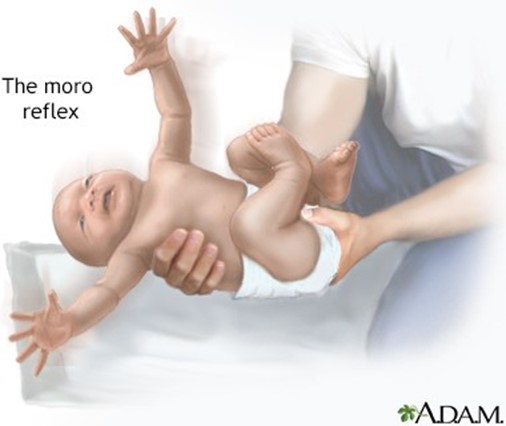A nurse is preparing to examine a post-term newborn immediately following delivery. Which of the following findings should she expect to observe? (Select all that apply.).
Moro reflex.
Vernix in the folds and creases.
Abundant lanugo.
Heel to ear maneuverability.
Correct Answer : A
Choice A rationale:

The Moro reflex is a normal finding in newborns, including those born post-term. It is a primitive reflex that should be present and indicates a healthy neurological system.
Choice B rationale:
Vernix, a protective white substance that coats the skin in utero, is typically absent or minimal in post-term newborns due to its decreased production as gestation progresses. Therefore, it would not be expected in a post-term infant.
Choice C rationale:
Lanugo, the fine hair covering a newborn's body, is usually present in greater amounts in preterm infants. By the time a newborn is post-term, lanugo is typically sparse or absent, making it an unlikely finding.
Choice D rationale:
This maneuver assesses the flexibility of the newborn's joints. Post-term infants tend to have reduced flexibility and increased muscle tone, making this maneuver more difficult or restricted in this population.
Nursing Test Bank
Naxlex Comprehensive Predictor Exams
Related Questions
Correct Answer is ["The medical term for the soft spot on a baby's skull is fontanelle (or fontanel)."]
Explanation
The medical term for the soft spot on a baby's skull is fontanelle (or fontanel). Fontanelles are gaps between the bones of the skull that allow for the baby's brain to grow and accommodate rapid brain development during infancy. There are typically two fontanelles in a newborn's skull: the anterior fontanelle (located at the top/front of the head) and the posterior fontanelle (located at the back of the head). These fontanelles are composed of connective tissue and remain open during the early months of life, gradually closing as the baby's skull bones fuse together over time. Healthcare professionals often assess fontanelles during routine physical exams of infants. The fontanelle's size and tension can provide valuable information about the baby's hydration status, intracranial pressure, and neurological development.
Normally, the fontanelles should feel relatively soft and flat, indicating proper hydration and brain development. If the fontanelles are sunken or overly tense, it may suggest dehydration or increased intracranial pressure, which requires further evaluation and management. The proper examination of fontanelles is an essential part of newborn care, and any abnormalities observed during assessment should be promptly reported to the healthcare provider for appropriate evaluation and intervention.
Correct Answer is A
Explanation
Choice A rationale:
The Moro reflex, also known as the startle reflex, is a normal reflex observed in newborns. To elicit this reflex, the nurse should perform a sharp hand clap or make a loud noise near the infant. This reflex is characterized by the baby's arms and legs extending outward, followed by a quick flexion, resembling a startle response. It is an important reflex to assess the newborn's neurological and motor development.
Choice B rationale:
Turning the newborn's head quickly to one side does not elicit the Moro reflex. This action may stimulate other reflexes, such as the tonic neck reflex, but it is not the appropriate method to assess the Moro reflex.
Choice C rationale:
Placing a finger at the base of the newborn's toes does not elicit the Moro reflex. This action is more related to testing the Babinski reflex, which involves the fanning and curling of the toes when the sole of the foot is stimulated.
Choice D rationale:
Holding the newborn vertically and allowing one foot to touch the crib surface does not elicit the Moro reflex. This action might elicit the stepping reflex, where the baby shows stepping movements as if walking when held in an upright position with their feet touching a surface.
Whether you are a student looking to ace your exams or a practicing nurse seeking to enhance your expertise , our nursing education contents will empower you with the confidence and competence to make a difference in the lives of patients and become a respected leader in the healthcare field.
Visit Naxlex, invest in your future and unlock endless possibilities with our unparalleled nursing education contents today
Report Wrong Answer on the Current Question
Do you disagree with the answer? If yes, what is your expected answer? Explain.
Kindly be descriptive with the issue you are facing.
